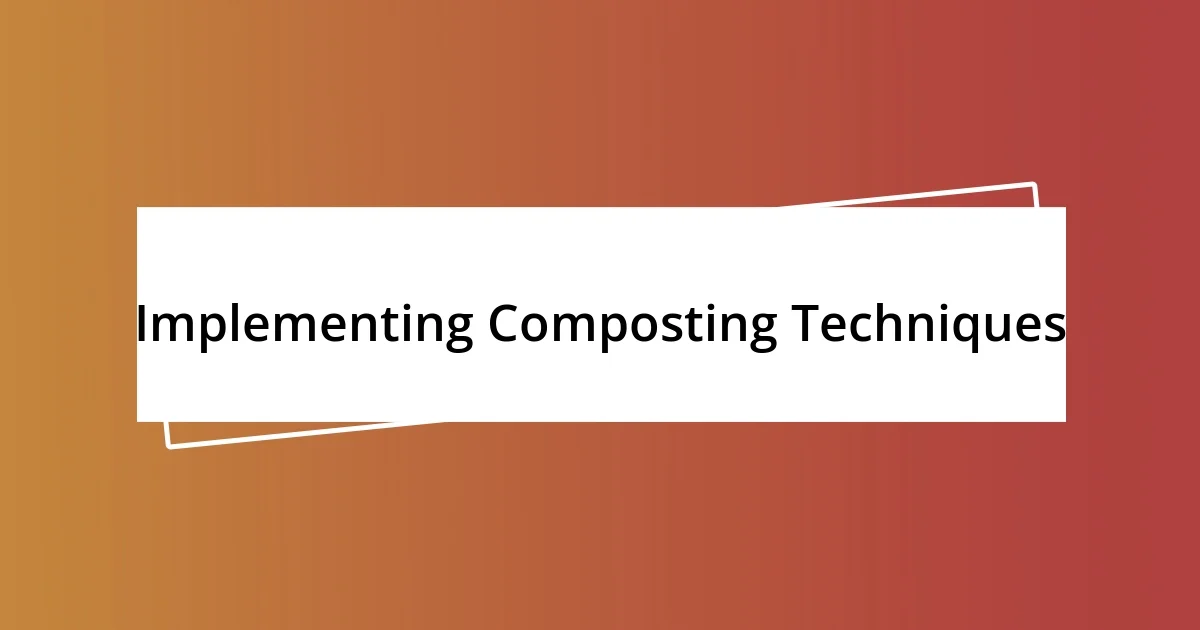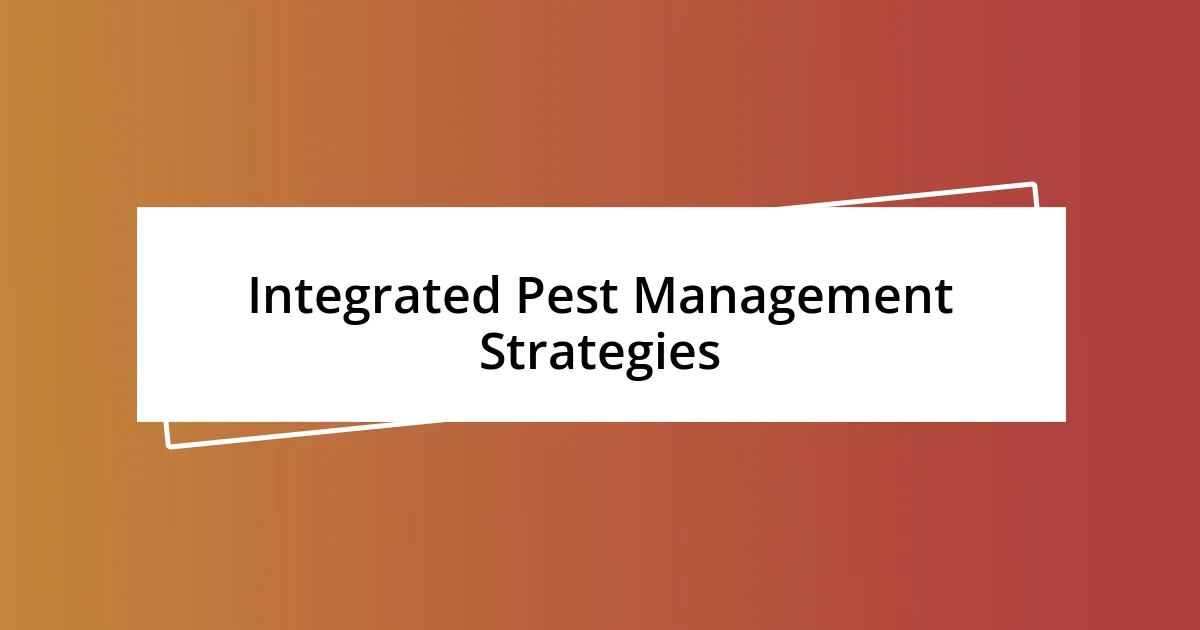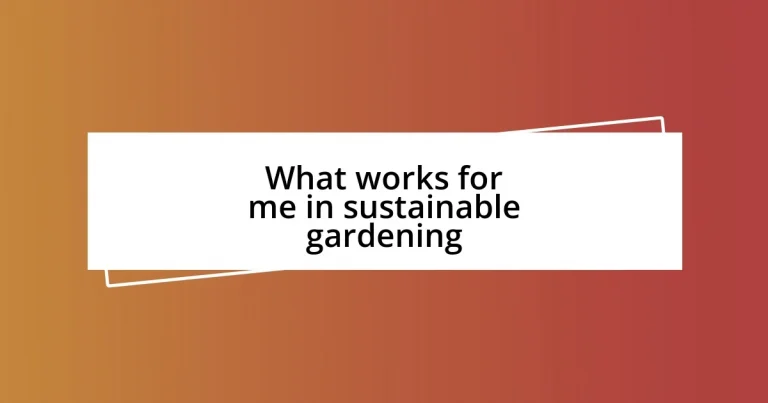Key takeaways:
- Sustainable gardening practices, such as composting and companion planting, enhance soil health and promote biodiversity while working harmoniously with nature.
- Utilizing rainwater for irrigation not only conserves resources but also nourishes plants, reinforcing a connection with the environment.
- Integrated Pest Management (IPM) strategies, including introducing beneficial insects and using organic barriers, provide effective pest control while maintaining ecological balance.

Understanding Sustainable Gardening Practices
Sustainable gardening practices revolve around working with nature rather than against it. I remember the first time I tried a compost bin; I was amazed by how kitchen scraps became rich, black gold. It felt like magic, turning waste into nourishment for my plants, and it made me wonder—what other hidden treasures can we find in our gardens?
Another crucial practice is companion planting, where certain plants support each other’s growth. I once planted marigolds alongside my tomatoes, and to my surprise, not only did the tomatoes thrive, but the marigolds also attracted beneficial insects. Have you ever tried pairing plants in your garden? It’s fascinating to see how they interact, almost like they have their own community.
Emphasizing native plants can create a resilient garden ecosystem. In my own garden, I’ve started incorporating local species, and the difference is striking. These plants require less water and attract local wildlife, creating a lush, vibrant environment that feels alive. Isn’t it rewarding to know our gardening choices can echo into the larger ecosystem?

Benefits of Sustainable Gardening
Sustainable gardening offers profound benefits that extend beyond our backyards. For instance, I often find myself reflecting on how these practices contribute to soil health. By using organic materials like compost, I’ve seen a significant improvement in soil texture and nutrient levels, which leads to healthier plants. The sense of fulfillment I get from nurturing the earth in this way is incredibly rewarding. It makes me feel deeply connected to the environment.
One of the most eye-opening benefits I’ve experienced is the reduction of my carbon footprint. By growing my own vegetables, I’ve noticed a significant decrease in trips to the grocery store, reducing both transportation emissions and packaging waste. It’s amazing to think that my small garden can contribute to a healthier planet. Have you ever considered how much more sustainable it is to harvest fresh veggies from your own backyard?
Furthermore, sustainable gardening fosters a deep connection with wildlife. I’ve noticed an uptick in butterflies and bees since I introduced more flowering plants. Watching these creatures flit about brings me immense joy and reminds me that my garden serves as a sanctuary for them. It’s a beautiful cycle of life, enhancing not only my garden but also the broader ecosystem.
| Benefit | Details |
|---|---|
| Improved Soil Health | Using organic materials enhances soil fertility and structure, leading to more robust plants. |
| Reduced Carbon Footprint | Growing your own food decreases reliance on transportation and packaging, benefiting the environment. |
| Wildlife Support | Providing habitats and food sources for local species fosters biodiversity in your garden. |

Implementing Composting Techniques
Implementing composting techniques has transformed my gardening routine in ways I never expected. I started small with a simple kitchen compost bin, and it felt like each time I dumped my vegetable peels, I was participating in a magical cycle of life. The warmth and earthy smell of decomposition reminded me that I was nurturing the soil, which in turn, nurtures my plants. It’s such a satisfying feeling to dig into a pile of compost and find dark, nutrient-rich soil—a little bit of treasure buried in my backyard!
Here are some effective composting techniques I’ve found helpful:
- Bokashi Composting: A fermentation method that allows you to compost kitchen scraps without the smell, making it great for indoor use.
- Layering: Alternating between green materials (like vegetable scraps) and brown materials (like dried leaves) promotes aeration and speeds up decomposition.
- Turning the Pile: Regularly aerating my compost by turning it with a pitchfork results in faster breakdown and prevents unpleasant odors.
- Thermal Composting: Building a hot compost pile helps to kill pathogens and weed seeds, accelerating the process significantly.
- Vermicomposting: Using worms to break down organic waste not only speeds up composting but also produces nutrient-dense worm castings, which my plants adore.
With these techniques, I’ve not only reduced waste significantly but also seen my garden flourish with health. The joy that comes from using my own compost feels like a secret handshake with nature!

Utilizing Rainwater for Irrigation
Utilizing rainwater for irrigation has been one of the most rewarding practices I’ve adopted in my garden. I found an old barrel tucked away in my shed, and turning it into a rainwater collection system felt like reviving a forgotten treasure. Each time it rains, I get that little thrill knowing I’m capturing pure, natural water right from the sky for my plants, reducing my reliance on tap water.
It’s fascinating how much water I save during dry spells. For instance, during a particularly hot summer, my rain barrel was a lifesaver, keeping my vegetable garden thriving while my neighbors were running their sprinklers. Have you ever noticed how your plants seem to perk up after a rain shower? That’s the magic of rainwater! It’s not just about conserving resources; it’s about nourishing my garden with that fresh, organic rainwater, which plants absolutely adore.
Collecting rainwater also deepens my connection to the environment. Watching the barrel fill up while a gentle rain falls brings a sense of harmony that really resonates with me. It’s like my garden and I are in sync with nature’s rhythms. Have you tried it yet? With just a few simple modifications, you can create this beautiful connection, and your plants will thank you for it!

Integrated Pest Management Strategies
Integrated Pest Management (IPM) has become a cornerstone of my gardening journey, allowing me to tackle pests in a way that feels natural and sustainable. One strategy that has worked wonders for me is introducing beneficial insects to my garden. Do you remember the last time you noticed ladybugs or lacewings flitting about? Their presence is a sign that nature is working in harmony. It’s incredibly satisfying to watch them do their job, preying on the aphids that used to plague my plants. This balance not only minimizes pest damage but also enhances the biodiversity in my garden.
Another tactic I swear by is companion planting. I vividly recall the first time I planted marigolds alongside my tomatoes. The vibrant flowers not only brightened up my garden but also acted as a natural deterrent to nematodes and other pests. Have you ever thought about how a flower could protect your vegetable patch? It’s remarkable how nature finds a way. This approach extends beyond aesthetics—by choosing the right companions, I’ve seen a significant reduction in pest problems while boosting my plant health.
I’ve also turned to using organic barriers, like row covers and sticky traps. One summer, I lost an entire crop of seedlings to pesky caterpillars, and I promised myself it would never happen again. The next season, I employed netting around my young plants, and I felt a wave of relief. I learned firsthand that sometimes the simplest solutions can provide the greatest peace of mind. Have you tried using barriers in your garden? These small efforts can yield big results, allowing you to protect your plants without resorting to harsh chemicals.

Creating Biodiversity in Your Garden
Creating biodiversity in your garden has transformed my outdoor space into a thriving ecosystem. I started by planting native species, which are naturally adapted to local conditions and attract various pollinators and birds. Just last spring, I noticed a sudden influx of butterflies and bees, completely mesmerized by their flitting dance around my blooms. Have you ever watched a busy bee collect nectar? It’s a small reminder of how interconnected life can be in our gardens.
One of the most gratifying experiences for me has been building diverse habitats. I’ve stacked logs and created small brush piles in a corner of my yard, seeing them quickly transform into cozy homes for beneficial critters. The other day, I spotted a family of toads nestled in the damp mulch—it’s thrilling to know they are helping keep pests in check. Adding layers like these not only diversifies the wildlife in my garden but also enriches the soil as they decay over time. How incredible is it to see nature’s recyclers at work right in our own backyards?
Another aspect I find essential is rotating crops in my vegetable garden. This practice sparks my creativity—each season feels like a new challenge to design the layout with different plant combinations. I remember the first year I swapped my squash for peppers in a specific patch: the yield was impressive, and it left me feeling like I had cracked a secret code in gardening. Have you explored how rotating your crops can lead to healthier plants and richer soil? It’s a simple yet effective technique that reinforces biodiversity while making gardening feel fresh and exciting.












